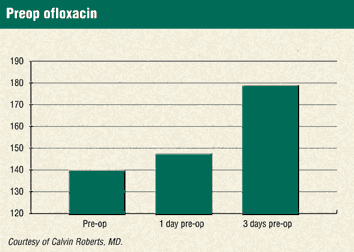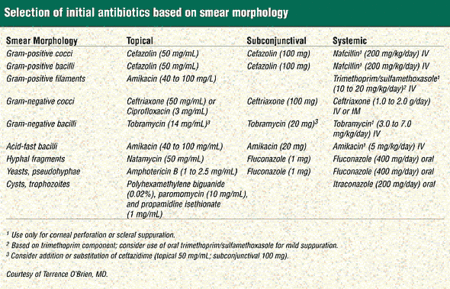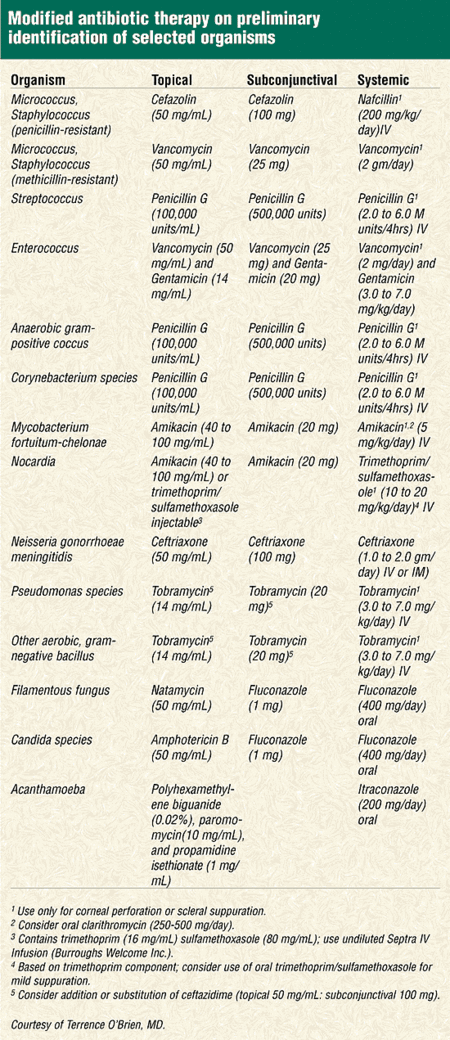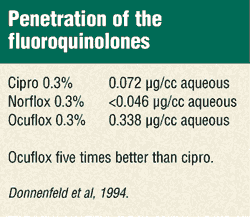What’s next for fluoroquinolones?
Fluoroquinolones are the current choice for ophthalmic infection and prophylaxis. Which is the best and when do you use it?
KOLOA, Hawaii — The introduction of ophthalmic fluoroquinolones in the previous decade “had a profound effect on ophthalmology,” said Jerold S. Gordon, MD, in a special session on the family of anti-infective drugs, held here at Hawaii 2001.
“Fluoroquinolones are topoisomerase inhibitors,” Dr. Gordon said. “They’re effective systemically as well as topically, and they are generally broad spectrum. We’re mostly interested in their effect on gram positives, because 90% of conjunctivitis and 75% of keratitis are gram positive. The more serious infections, the gram negatives, such as Pseudomonas and Serratia, are very effectively dealt with by the fluoroquinolones.”
The two most familiar ophthalmic fluoroquinolones, Ciloxan (ciprofloxacin HCl, Alcon) and Ocuflox (ofloxacin, Allergan), have a large share of the anti-infective market – combined, about 66% of the market share, according to a representative of one of the manufacturers. A newer entry, Quixin (levofloxacin, Santen) is also gaining popularity.
Dr. Gordon warned, though, that there is a cloud on the horizon — emerging resistance to fluoroquinolones. His lab has reported ciprofloxacin resistance in Staphylococcus aureus, and others have reported resistance with Pseudomonas.
Perhaps just in time, newer fluoroquinolones are approaching the marketplace. At least two new fourth-generation compounds are in development by major ophthalmic pharmaceutical companies. This article reviews the presentations at a special session on ophthalmic fluoroquinolones at Hawaii 2001, the Royal Hawaiian Eye Meeting, sponsored by Ocular Surgery News in conjunction with the New England Eye Center.

What is coming?
The chemical structures of fluoroquinolone molecules account for differences in potency. Fluoroquinolones have eight positions on the molecule, which allows for an infinite variety of chemicals that can be attached to each of these eight positions. Dr. Gordon said there are currently more than 10,000 fluoroquinolones being researched.
For clinical use, ophthalmologists can look forward to the third- and soon fourth-generation fluoroquinolones.
Levofloxacin is a third-generation fluoroquinolone introduced by Santen as Quixin. Gatifloxacin is a fourth-generation fluoroquinolone that Allergan has in the pipeline, and moxifloxacin is a fourth-generation drug in Alcon’s pipeline.
Levofloxacin, the third-generation fluoroquinolone, is a levo-isomer, essentially the L form, of ofloxacin, Dr. Gordon said.
“It is not a new drug — it is the active form of a mixture that we’re already using. It’s 0.5% levofloxacin, compared to 0.3% ofloxacin, but 3.3 times more concentrated,” he said.
In the lab, Dr. Gordon looked at 93 isolates of Staphylococcus and 107 isolates of Pseudomonas that were taken from corneas that were both fluoroquinolone sensitive and resistant. He compared levofloxacin, ofloxacin and ciprofloxacin to see if the newer levofloxacin would offer an advantage. Using minimal inhibitory concentration and time kill studies, he found that for susceptibility, all three drugs were equivalent for both sets of isolates. If there was resistance, the resistance was comparable across all three drugs.
“So the question is, will levofloxacin offer any advantage in practice over the second-generation fluoroquinolones? And the answer will depend on whether or not the concentration effect is significant,” Dr. Gordon said.
A time kill study comparing the three drugs showed there was no difference in the time kill for Staphylococcus aureus as well as for Pseudomonas.

The future of fluoroquinolones
“However, I think the true excitement and the next giant leap into the future is with the fourth-generation gatifloxacin,” Dr. Gordon said. “It is (Food and Drug Administration)-approved, called Tequin, and is made by Bristol-Myers Squibb. It was principally developed as a respiratory agent, and its major claim to fame, and this is an important one, is increased gram-positive sensitivity. It’s generally safe orally and through an IV.”
From a resistance point of view, it is a DNA gyrase inhibitor, and organisms need two independent mutations to acquire resistance.
Moxifloxacin is also a fourth-generation fluoroquinolone. Bayer Corporation markets it as Avelox, as a systemic drug, and it essentially mirrors gatifloxacin in its indications and general characteristics.
Dr. Gordon displayed a table comparing gatifloxacin and moxifloxacin to ciprofloxacin, using ciprofloxacin as a standard. He showed that against sensitive gram positives the new medications are far more potent against resistant organisms. “For gram negatives the new medications are a little less potent. But this may not be significant clinically when we put it into patients’ eyes,” Dr. Gordon said.
In terms of the half-life in patients, the new generations have longer half-lives, but more important, for gatifloxacin and moxifloxacin, it took longer to make mutants than it did for ciprofloxacin.
Dr. Gordon mentioned several other drugs on the horizon. Linezolid is an oxalidinone from Pharmacia marketed as Zyvox for systemic use. It is not a fluoroquinolone. “It is FDA approved, and it’s a fully synthetic antibiotic. It works by inhibiting RNA translation, and it inhibits the virulence factors of S aureus. It is a gram-positive-only antibiotic. It’s static for Staphylococcus and cidal for Streptococcus. It’s indicated for vancomycin resistance and community-acquired pneumonias and skin infections. There is a toxicity profile, particularly myelosuppression. But the most important thing about linezolid is there is no cross-resistance with current antibiotics,” he said.
For the future, Dr. Gordon said there are several new drugs and groups of drugs on the horizon.
New fluoroquinolones include temafloxacin, which is in the final stages of FDA approval.
Peptide deformylase inhibitors are a group of drugs that block a critical bacterial enzyme in protein synthesis.
Pleuromutulins are currently in veterinary use for enteric and respiratory infections. They block protein synthesis of bacteria.
Efflux pump inhibitors will overcome existing resistance, Dr. Gordon said.
Cationic peptides make “holes” in bacteria.
Also on the horizon are quorum-sensing inhibitors that block the expression of virulence factors.
Finally, sortase inhibitors block the microorganism’s adherence.

Killing quickly with efficacy
Calvin Roberts, MD, noted at the meeting that although the FDA-approved indications for fluoroquinolones are for bacterial conjunctivitis and corneal ulceration, the principal ophthalmic use of the drugs is for antibiotic prophylaxis in cataract and refractive surgery.
Dr. Roberts said he had evaluated the drugs for three aspects — their efficacy, formulation and penetration.
“Fluoroquinolones are exquisitely effective drugs in the treatment of the bugs that we’re concerned with in our prophylaxis,” he said. “In cataract surgery, we’re dealing with primarily gram-positives, Staphyloccocus epidermis, Streptococcus and S aureus. And in our LASIK and other refractive surgeries, we’re concerned about primarily Pseudomonas and also the gram-positives.”
According to Dr. Roberts, with formulation two things are important: solubility and chelation, because these drugs have to be in solution in order to be effective. When the pH is raised, it decreases the solubility, forcing the drug out of solution. He believes this is important because the pH of fluoroquinolones vary significantly. The pH of Ciloxan is 4.5. The pH of Ocuflox is 6.5.
“As you know, pH is a logarithmic function, so that what we’re looking at is 100 times greater solubility for Ocuflox than it is for Ciloxan. When we raise these drugs up to normal pH, using them in the eye, you’re going to see a massive difference in terms of the solubility with lots more of the Ciloxan coming out of the solution, forming microprecipitates. The Ocuflox, with much greater solubility, will stay in solution. We saw this in our corneal ulcers where the drug precipitates in the white plaque of Ciloxan that sits on the corneal ulcer. Clearly that drug is not effective,” Dr. Roberts said.
In terms of chelation, he said that Ciloxan has been shown to have a very strong chelation effect. A study published last year in Cornea showed that the effectiveness of Ciloxan, when in the presence of metal cations such as in the aqueous, was 29%, while Ocuflox was 94% effective.
“Several studies in the literature have shown that Ocuflox penetrates into the cornea three times faster than Ciloxan. It penetrates into the anterior chamber five times faster than Ciloxan. When we think about prophylaxis of endophthalmitis, to me, I’m thinking of two things: what can I do to decrease the number of bugs that are present in the eye, and what can I do to minimize the chance that bugs that are inoculated in the eye at the time of surgery are going to have the opportunity to grow?” Dr. Roberts said.
Drug penetration results
In a study evaluating surgical prophylaxis, Dr. Roberts investigated how much drug permeated into the anterior chamber with various dosing regimens. Using Ocuflox drops, he randomized patients into three groups. The first group started with drops just when they arrived at the surgery center, getting drops every 15 minutes for four doses, beginning 1 hour preop.
The second group started the day before, using the drops four times a day and then using them along with their dilating drops at the surgery center. The third group started 3 days prior to surgery and used them along with their dilating drops.
In this randomized, masked study, prior to surgery Dr. Roberts did a paracentesis of each eye, drew out some aqueous and sent it out for HPLC analysis. He found that the patients who had 3 days of preoperative antibiotic prophylaxis had a statistically significant increase in the amount of drug present in the aqueous at the time of surgery.
“You may say, ‘Well, that’s great, but all that drug is going to run out of the eye as soon as the eye is opened.’ And that’s true, but what we were measuring was aqueous as an indicator of how much drug is sitting in the cornea, the iris, the ciliary body, acting as a reservoir of drug so that when any bugs may be inoculated into the eye, you have the highest likelihood of being able to resist infection. With the levels that we were able to achieve here with 3 days preop, we were exceeding the minimum inhibitory concentration for the gram-positives,” Dr. Roberts said.
Fluoroquinolones battling keratitis
The risk factors for keratitis are well known, and despite advances in refractive surgery, there are still approximately 25 million people in the United States who wear contact lenses, which can represent a major potential for transmitting bacterial organisms to the ocular surface and increasing the risk for infection.
 “The difficulty has been, how in your office to diagnose the potential pathogens that are present in suspected acute microbial keratitis, and why it’s difficult, in many ways, to do this quickly and efficiently,” said Terrence P. O’Brien, MD, another presenter at the symposium. “Because we’re not always certain as to organism identity and susceptibility, and time matters, the traditional approach has been to use a broad-spectrum agent or a combination of agents rather than a narrow-spectrum compound. I must admit that I’m biased against empiric therapy, rather I prefer culture-directed therapy because I think it’s always helpful to know your enemy in advance. There is no single antibacterial agent that covers the entire microbial world so we’ll never have that omnipotent single agent,” he explained.
“The difficulty has been, how in your office to diagnose the potential pathogens that are present in suspected acute microbial keratitis, and why it’s difficult, in many ways, to do this quickly and efficiently,” said Terrence P. O’Brien, MD, another presenter at the symposium. “Because we’re not always certain as to organism identity and susceptibility, and time matters, the traditional approach has been to use a broad-spectrum agent or a combination of agents rather than a narrow-spectrum compound. I must admit that I’m biased against empiric therapy, rather I prefer culture-directed therapy because I think it’s always helpful to know your enemy in advance. There is no single antibacterial agent that covers the entire microbial world so we’ll never have that omnipotent single agent,” he explained.
“We’ve heard how the quinolones have evolved to have better broad-spectrum coverage, including an expanded spectrum of activity against the gram-positives that are more common in our series of bacterial keratitis accounting for about 75% of cases over the past few years. We’re getting better pharmacodynamics and spectrum now with compounds like levofloxacin, which is not yet FDA-approved for the indication of keratitis. But we have a better feel or appreciation that quinolones can be effective based on the clinical trials that were conducted showing that, compared to fortified antibiotics, a single-agent fluoroquinolone agent can be at least as effective.”
Dr. O’Brien said that when faced with a situation where he has no or equivocal information from culture to narrow his choices, he makes a severity assessment.
“You’re going to need anti-bacterial therapy. If it’s non-severe, rethink the process of what could be going on clinically. If you suspect it is bacterial keratitis, there’s where a quinolone agent might be helpful. If it’s a maybe or a no in terms of likelihood of infection, probably you’re better off not to use an antibiotic or wait for laboratory confirmation of infection.”
Dr. O’Brien said the exciting new agents coming out, moxifloxacin and gatifloxacin, are expected to provide an expanded spectrum of coverage.
“We’ve conducted laboratory investigations of these expanded spectrum quinolones, including in vitro susceptibility testing, and found that they do indeed have better gram-positive coverage, especially against Streptococcus pneumoniae,” he said. “We’ve plugged them into animal models of severe keratitis, and trovofloxacin, gatifloxacin and moxifloxacin are superior for gram-positive keratitis compared to the current commercially available fluoroquinolones, ciprofloxacin and ofloxacin. This is particularly true for streptococcal keratitis.”
Against Pseudomonas, Dr. O’Brien said the newer agents maintain similar activity to ciprofloxacin and ofloxacin.
He suggested that for acute bacterial keratitis, it is important to make the clinical assessment of severity. If it is severe, central and sight-threatening, he prefers a combined approach with cefazolin 50 mg/mL and ciprofloxacin or one of the other available quinolones.
“If it’s mild, non-central, non-sight-threatening, I think a single-agent fluoroquinolone like ciprofloxacin or one of the others that are commercially available is helpful,” he said.
“But right now don’t abandon the fortified agents for severe cases. A major goal for the future is to develop better strategies to prevent tissue destruction and to stop the matrix metalloprotease expression during these infections that contribute to scarring and loss of vision,” Dr. O’Brien said.
Fluoroquinolones in refractive surgery
“I really can’t think of a more devastating outcome than having an infection in a LASIK patient,” said Robert W. Snyder, MD, before offering his pearls in preventing infection in refractive surgery.
Strategies to prevent postoperative infection include three factors, according to Dr. Snyder. One is to prevent or minimize the inoculum or contamination. Two is to treat the inoculum or contamination if it occurs so that you eradicate the organism. And last is to prevent bacterial colonization while the eye is still healing and there is an epithelial defect.
First and probably foremost, Dr. Snyder uses Betadine (povidone-iodine, Alcon), which has been shown in studies to be effective at sterilizing and significantly reducing the number of bacteria on the lids.
The 10% solution of Betadine can sting, so he uses the commercially available 5% solution, applied in the cul-de-sac.
“The way Betadine works is the iodine, the free iodine, is an oxidizing agent. The amount of free iodine that is in solution is about the same for a 1:2 dilution of this, a 1:5, a 1:10 and even 1:50 dilution. So you can dilute out the 10% Betadine to 1/10 and still have very effective amounts of free iodine. The problem is that the free iodine is not stable in solution on the shelf for a long period of time. So what we do is we mix it up in the morning, and we’ll use it that day. I would not advocate mixing a bottle of this up, putting it back on your shelf and using it a few days later,” Dr. Snyder said.
He noted that diluted Betadine may be safer on the conjunctival goblet cells as well, as there has been some evidence that one can damage the goblet cells with 10% Betadine.
Dr. Snyder’s method is to use a 1:5 or 1:10 solution of Betadine in the cul-de-sac and on the eyelids.
“I use this little chopstick technique, where I’ve got two Q-tips soaked in the Betadine. I pull the lid down with my other hand an a third Q-tip. I run the pair of Betadine-soaked Q-tips right across the lid margin. The solution tip gets into the cul-de-sac and coats the lashes. Here I use a pre-soaked Betadine swab. And then we use full-strength Betadine on the skin. I believe that’s very adequate in significantly reducing the number of organisms in the tear film,” he said.
He also advocates putting a sterile or plastic drape or tape over the lid margins and isolating the lashes and the lid margins. He said meibomian gland secretions may cause inflammation. “Certainly, the lid margins are where the bacteria are,” he said.
Dr. Snyder said he prefers to use a “very wide and supple tape. The key is you want something that is supple, so it’s easy to turn under the lids. You want something that’s relatively easy to put on with your hands so you don’t end up with this stretching across the nasal contours and inhibiting perhaps the movement of the keratome.”
The next issue is treating the inoculum. “I advocate using antibiotics in the postoperative period for excimer laser refractive surgery simply because we don’t know much about the secondary fluorescence of these compounds, and they do fairly well absorb the excimer wavelength. And so I don’t know if it’s going to change the effective ablation rate. I don’t use them preoperatively for that reason,” Dr. Snyder said.
Quinolone use and efficacy
According to Dr. Snyder, what any surgeon wants is an ideal antibiotic, something that is broad spectrum, fast-acting, with high solubility, sustained tear levels and low toxicity.
“The clear choice is a quinolone,” he said. “If you look at the susceptibilities, the quinolones win hands down because they get both gram-negatives and, more important, gram-positives.”
He pointed out that while there are differences among the quinolones, they are subtle when comparing ofloxacin, ciprofloxacin and levofloxacin, he said. “Levofloxacin is simply the L-isomer of ofloxacin, so the susceptibility pattern should be very similar or the same. And cipro is pretty close. Cipro might be a little bit better for Pseudomonas but not quite as good for gram-positives, but that’s really a close call, I think.”
The kill rates of Ocuflox and Ciloxan compared side by side are about the same, Dr. Snyder said, while levofloxacin has not been studied in that sort of a comparison.
“The penetration I think is important with LASIK. You want something that gets into the flap. The data that we have clearly shows that Ocuflox gets in about five times better. Levo may be a very good drug here but the data is not out, the penetration studies have not been done. Ocuflox gets in about two to five times faster than ciprofloxacin does. We found that in the deep stroma, where you’ve got significantly better penetration of Ocuflox by about two times,” Dr. Snyder said.
“In studies by Drs. Perry, Donnenfeld and others, we found that dehydrating and leaving a rabbit eye under a microscope for 2 minutes, rehydrating it with either antibiotic or tears, and then looking at the concentrations in the cornea adequately augmented the amount of antibiotic in the corneal stroma. He felt this testing device mimicked the LASIK model. When the cornea becomes dehydrated or you’re letting a flap dry at the end of the case, put the antibiotic on. With ciprofloxacin you get a little enhanced from 11 to 19 mcg/gram of tissue. With ofloxacin, you get tremendous enhancement from 16 to 49 mcg/gram of tissue. With tobramycin, you just don’t get much effect,” he said.
He pointed out that the cornea works like a therapeutic sponge, and the soluble ofloxacin and solution is a little bit better than ciprofloxacin, which tends to be a precipitate at the pH of the tear film.
On the issue of safety, Dr. Snyder looked at epithelial healing and did not find much difference between Ocuflox and Ciloxan. “Richard Yee, MD, looked at it, and he did find some difference between Ocuflox and ciprofloxacin, where Ocuflox promoted quicker healing than ciprofloxacin did. Maybe it’s because of the precipitate with ciprofloxacin, since this study used aggressive dosing. I don’t know, but we really haven’t seen a great deal of difference between those two drugs. Both of them seem to stay in the tear film. All of them seem to stay in the tear film at reasonably good rates for a reasonable period of time.”
Dr. Snyder suggested using an antibiotic until the epithelial barrier is re-established. Once that is established, there is no need to carry antibiotic use on for more than another day.
For Your Information:
- Jerold S. Gordon, MD, can be reached at 203 Lothrop Street, Pittsburgh, PA 15213; (412) 647-2212; fax: (412) 647-5119; e-mail: yjgordon@vision.eei.upmc.edu. Dr. Gordon does not have a direct financial interest in any product mentioned in this article, nor is he a paid consultant for any company mentioned.
- Robert W. Snyder, MD, can be reached at 1801 North Campbell Ave., Tucson, AZ 85719; (520) 321-3677; fax: (520) 321-3665; e-mail: rsnyder@eyes.arizona.edu. Dr. Snyder has no direct financial interest in the products mentioned in this article, nor is he a paid consultant for any companies mentioned.
- Calvin Roberts, MD, can be reached at 876 Park Ave., New York, NY 10021-1832; (212) 734-7788; fax: (212) 734-4476; e-mail: robertsmd1@aol.com. Dr. Roberts did not disclose whether he has a direct financial interest in the products mentioned in this article or is a paid consultant for any companies mentioned.
- Terrence P. O’Brien, MD, can be reached at Wilmer Eye Institute, 600 N. Wolfe St., Wilmer Woods 255, Baltimore, MD 21287-9121; (410) 955-1671; fax: (410) 614-0682; e-mail: tobrien@gwgate1.jhmi.jhu.edu. Dr. O’Brien is a paid consultant for Alcon, Allergan, Pharmacia and Santen.
- Alcon Pharmaceuticals, manufacturers of Ciloxan, can be reached at 6201 South Freeway, Fort Worth, TX 76134; (800) 826-5266; fax: (817) 241-0677. Allergan, manufacturers of Ocuflox, can be reached at 2525 Dupont Drive, Irvine, CA 92612; (800) 433-8871; fax: (714) 246-5913; Web site: www.allergan.com.
